Contributor
How Many ($) Millions Are Hiding Under Your Marketing Data?
Contributor
“Getting numbers is easy; getting numbers you can trust is hard!” – Ronny Kohavi, Head of Experimentation at Bing
As one of the data scientists on my team once said, “Marketers need less technology and more data. But also, they need less data and more insights.” This simple statement paints a good picture of what has happened with digital marketing over the last decade. Gradually, over the years, we saw the focus shift from growing a large platform stack to developing better data exploitation capabilities for the existing stack. Naturally, a focus on data will lead to a focus on insights, which leads to actual business value. But the real question behind this evolution is, how did marketing tech stacks become so messy?
The Rise and Fall of Platform Hoarders
It all started in the early 2010s, when digital and analytics marketers — like myself, admittedly — were basking in the seminal stage of what I’d call the Platformer Age. This was the great technological revolution of digital marketing. Google Analytics was coming of age and Adobe Analytics (known then as Omniture) was the Ferrari of data for e-commerce. The CRM had a mystical and prestigious aura about it and programmatic ad buying, then known as “yield management,” was fast gaining momentum among more advanced marketers.
Then, in the mid-2010s, new generations of marketing cloud platforms like DMPs, SSPs and DSPs became wildly popular. Simultaneously, Data Connection platforms like Domo and Datorama were starting to gain momentum. In the realm of email marketing, the big hype was around marketing automation platforms from Adobe, Salesforce, HubSpot and others. The last decade also gave rise to personalization platforms to do A/B testing of landing pages or personalize website experiences, such as Sailthru, VWO and Optimizely. Essentially, marketers became overwhelmed with platform options to choose from. Additionally, there was a shortage of qualified marketers capable of implementing and successfully using most of these new tools.
As such, this gave rise to two important marketing personas that ruled supreme during the 2010s: The Platformer and its main antagonist, the Platform Hoarder. To explain these two personas, we had a little fun by illustrating them as robot characters inspired by the famous cartoon series and toy collection called the Transformers. In the back of each toy set, you’ll usually find a chart explaining the robot’s personality and key strengths. To capture the spirit of the Platformer and Platform Hoarder, we designed similar looking charts:
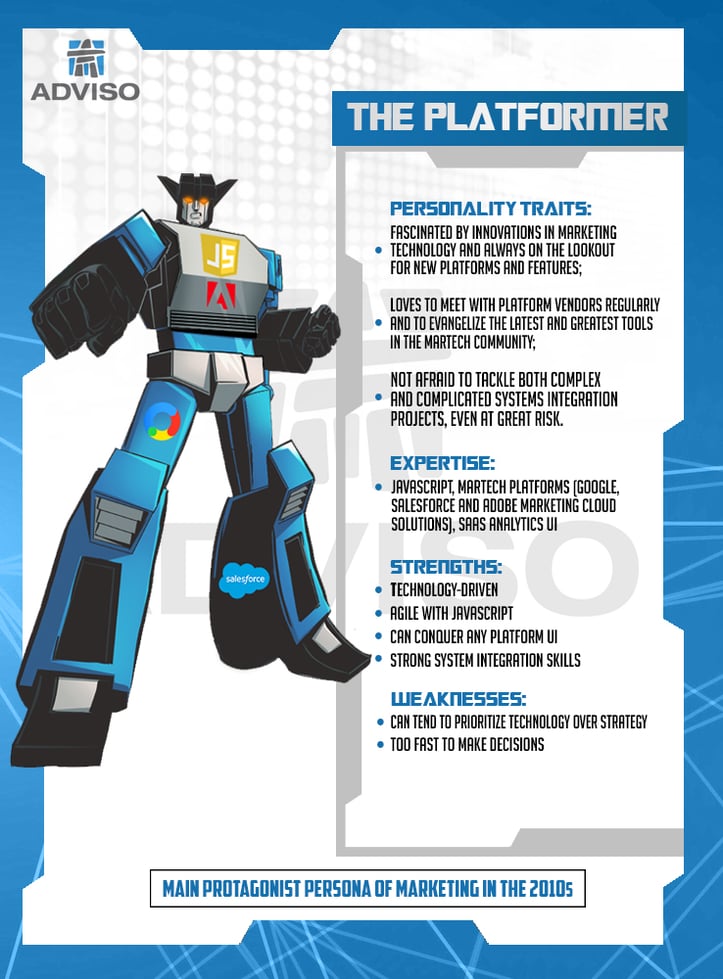
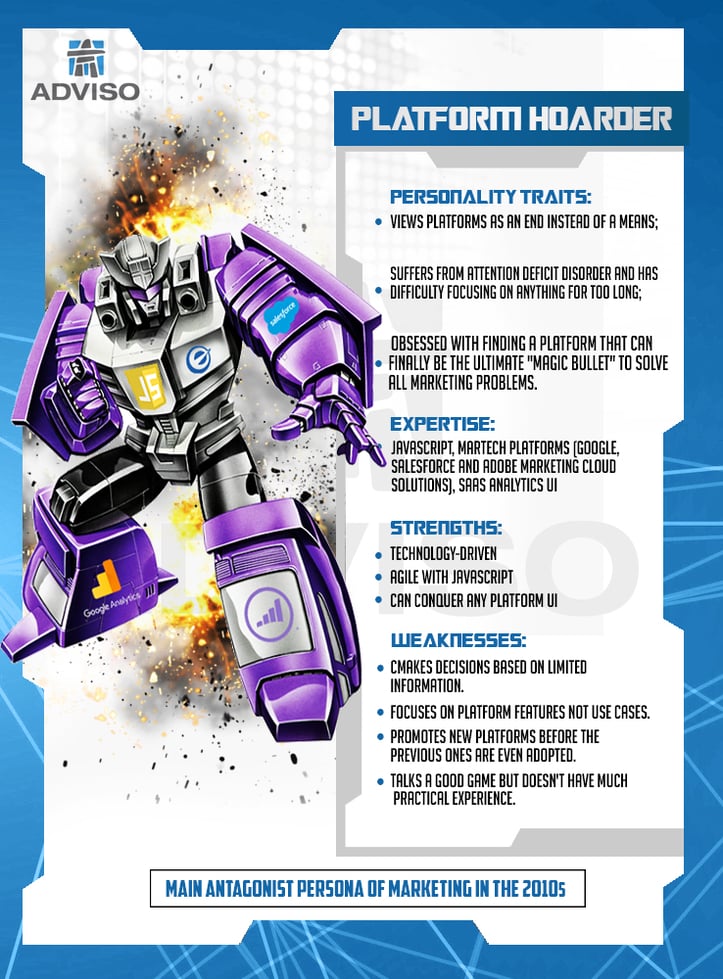
Is Your Tech Stack Complex, or Just… Complicated?
Given all the extravagant, almost magical promises made by this plethora of impressive platforms, marketing departments sunk millions of dollars into a hoard of technological tools. According to Toolbox, marketers average up to 16 MarTech platforms in their stack (and up to 20 for B2B marketers). Moreover, because these tools often come with long and costly IT implementations, it was often years before many analytics and MarTech projects returned any sort of measurable business value. In quite a few cases, they never did. And that’s when things got complicated.
One of the main reasons for this high platform failure rate is due to the obsession digital marketing teams have with collecting and tracking literally EVERYTHING. This obsession with hyper-granularity often creates overly complicated (not complex) data layers and never-ending data discrepancy problems. The reason I say complicated and not complex is because many data layers and metrics bring little business or marketing value. For instance, if tracking a certain custom event on your website requires hundreds of hours of implementation, but only affects 5% of your traffic and 0.2% of your e-commerce revenue, was it worth the complication? Now, keep in mind that hyper-granularity is not bad, in and of itself, as long as the effort yields a commensurate business impact.
Now, going back to the notion of complexity, in the fields of physics and chaos theory, the definition of a complex system is the following, according to Dr. Karoline Weisner:
“It boils down to something that consists of many elements that are interacting in a disordered way out of which is generated a robust order. There is nothing that controls centrally how things are supposed to behave.”
Also, complexity relates to advanced, coherent, modular and emergent properties of a given system, while a complicated system refers mostly to a system with inherent complications that may or may not be coherent, advanced or even useful. For example, the human body, and even cars have the properties of being complex, advanced, coherent and thus valuable systems (at least in principle… 😏). On the other hand, poorly thought-out business processes can be overly complicated for no reason, which makes them simply complicated, not complex. Was that explanation simple enough for you (pun intended)?
Sadly, many analytics and ad/MarTech implementations give marketing and business executives (who are barely keeping up with all the tech buzzwords and acronyms) the illusion of complexity. But in reality, they are just very complicated because they were poorly thought out. As a result, IT and marketing analytics teams end up focusing most of their energy on bug fixes and plumbing operations, often at the expense of working on higher value activities like strategy, data mining and optimization.
The Need for Data and Technological Orchestration
More and more time and money is being burnt on shiny new analytics and MarTech objects, but even so, as they begin to age they are eventually, unavoidably hoarded away in our collective tech stack junkyards. Furthermore, the platforms that do survive in various departments are typically run in silos with hardly any common orchestration strategy or concerted marketing plan. The email platformers don’t speak to the programmatic platformers, who don’t speak to the website personalization platformers, who don’t speak to the analytics platformers, except when there’s a need for new tagging integrations. It’s a disjointed mess!
The real key to achieving a truly complex and valuable tech stack, is to develop a robust architecture and orchestration strategy to connect all your platforms together coherently and in a modular way. This is something like what we see emerging with microservices among app developers.
Looking back at a decade of the Platformer Age, all of the failed promises and disappointments have created a steep valley of disillusionment among both IT professionals and marketers. In fact, as far back as 2018, eMarketer reported that U.S. advertisers were cutting down on programmatic platforms by 40%. According to Forrester, venture capital took a real notice of this trend, and investment in MarTech and AdTech was predicted to drop by 75% in 2019. This represented the slowest growth among technology markets tracked by the Forrester study. Furthermore, the announcement of a confirmed date for the third-party cookie apocalypse will likely make marketers even more hesitant to invest in yet more platform integrations in their stack, especially for advertising.
As pointed out in an article by Alison Weissbrot in AdExchanger, even the much-hyped Customer Data Platforms (CDPs), which are often seen as logical successors to DMPs in a post-cookie apocalypse, are being adopted with more caution and circumspection. As Weissbrot points out:
“As marketers move on from DMPs, they’re taking these learnings – and a heavy dose of skepticism – with them as they test new technologies.”
Now, the point is absolutely not to say that platforms are bad or not important for marketers anymore. In fact, we have plenty of successful platform case studies to prove otherwise. Rather, the key takeaway is that tech hoarding, especially without a clear People, Process, Platform plan (in that order), takes marketing attention away from what matters most, which is an actual analytics and activation strategy.
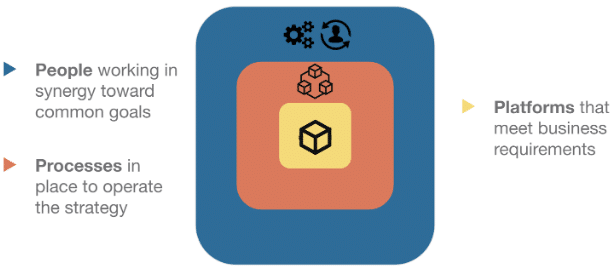
Marketing in the 2020s: The Data Transformer Age
With CMOs and CDOs under more pressure to justify their investments in analytics and MarTech platforms, marketers are coming into the 2020s with a new mission of extracting data and business value from their existing tech stack, before investing in new platforms. No more open bars! eMarketer’s Marketing and Ad Tech Trends 2019 Roundup, shows how companies worldwide have been shifting focus on data, metrics and analysis over the last five years. In fact, of those companies surveyed, 67% said their focus was drastically shifting toward data and analysis, therefore less toward platforms themselves.
This is the beginning of what I’d call the Data Transformer Age of marketing. If data is the new oil, then refining your data generates the fuel to propel your business forward. And with all the data sitting around in the 16 to 20 analytics and activation platforms in your marketing department, you should have plenty of data to analyze. Big data, to be more specific.
The most exciting part of all of this, is the unexplored potential of data unification between web analytics, marketing technology and legacy BI systems. As more and more BI practitioners become aware of the enormous potential to be found in digital marketing data sources, from Google/Adobe Analytics to all the esoteric programmatic tools used by marketers, finding ways to transform and normalize this data could uncover unprecedented business insights and opportunities.
In this new decade, the Data Transformers will begin to take centre stage as the spotlight moves away from the Platformers. The latter won’t go away (except for the Platform Hoarders), they will simply evolve toward a new marketing role as Platform Orchestrator. Your Data Transformers will be found in newly created roles like Customer Data Leads, Data Strategists and Analytics Translators. Behind those new roles will be a supporting cast doing all the magic in the backend, like Data Scientists, Data Engineers and Analytics Developers. However, beware of its main antagonist, the Data Hoarder!
Once again, to capture the spirit and skillset of both the Data Transformer and Data Hoarder, who will likely become the dominant personas of the 2020s in marketing, we created these fun charts inspired by the Transformers cartoon series and toy collection:
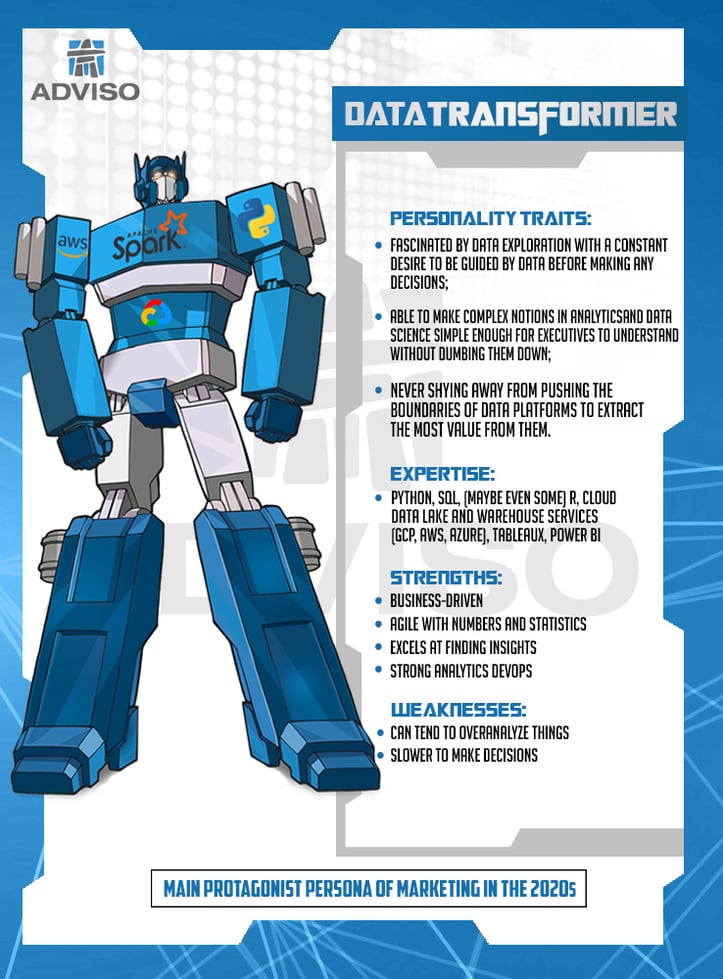
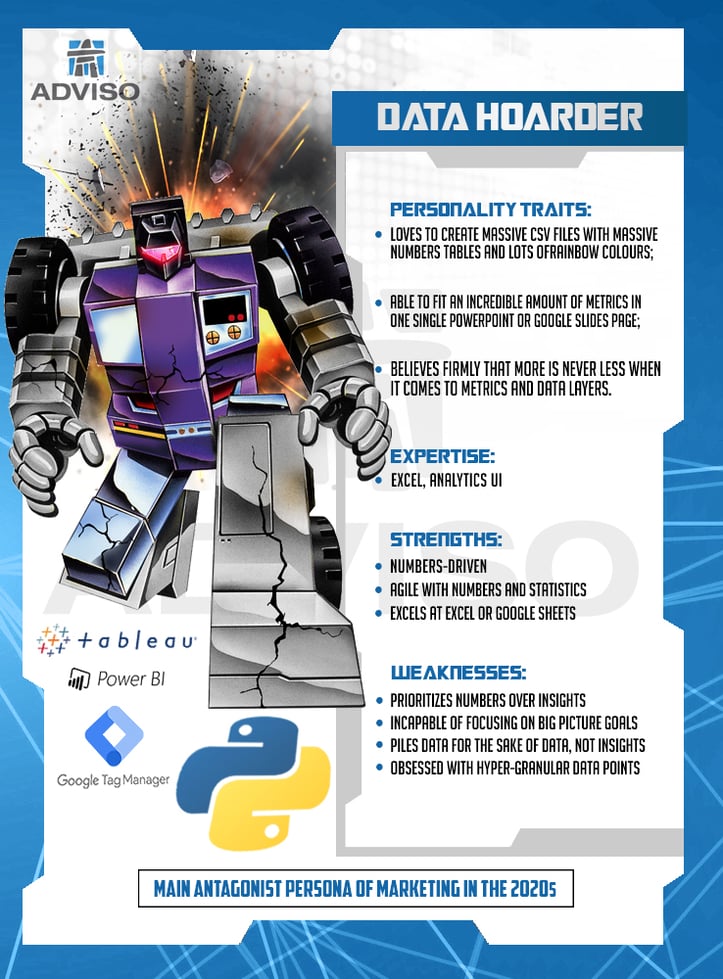
While the activation part (such as marketing campaign management in the platforms) will remain with digital marketers in the UI, the raw data from analytics and MarTech platforms will be pipelined as raw materials by data engineers toward Big Data cloud platforms like Google Cloud, Amazon and Azure. It will then be processed by AI algorithms and visualized in dashboards for analysis, decision making and ultimately business and marketing activation.
In many companies, all of this is already in motion and efforts are being made to materialize this vision. But if your company hasn’t done so yet, here is why you need to get started, right away!
Unexplored Marketing Data Could Be Costing You Millions
As my colleague Moulaye Traore points out in his brilliant article on augmented analytics, there is a very real, concrete and measurable ROI to finding business insights. If on average, an insight derived from data can drive a $25K performance gain, optimizing that average to $50K means you double your marketing performance. The key challenge to optimizing insight production is proper data exploration. The more time an organization can consecrate to exploring new patterns in data, the more new opportunities it can uncover.
When you’re only dealing with one or two data sources, this process can be optimized fairly easily. But in the context of exploring data from a large span of analytics and MarTech platforms, data mining can become more challenging. On the other hand, there is also a great opportunity to discover many more performance blindspots in your marketing activities across channels. Conversely, there is also the possibility of identifying important inefficiencies in this great big pile of multi-platform data.
In fact, the unexplored marketing data from your many platforms could be hiding millions of dollars in both efficiency gains and performance opportunities. But until and unless you organize your analytics framework to exploit and mine this data, you will never find out.
My career advice to you is this: don’t wait for the next rockstar in your company, who will likely be a Data Transformer, to do it for you. Become that rockstar! Take the leap into this new age in marketing and be proactive about mining your analytics and MarTech data. Before you jump to a new technology, maximize the potential of the platforms you already have. By taking a second and deeper look at the data in your existing platforms, like Google/Adobe Analytics, Facebook/Google Ads, HubSpot, your ad server, Marketo, Salesforce DMP, Segment CDP, Adobe Target, Google Optimize and probably many others buried in your stack, you might find they hold more than meets the eye. So in the famous words of Optimus Prime, time to ROLL OUT [the data]!!
PS. Only Transformers fans will recognize the above reference 😎
If you need help with the development of a marketing data exploration roadmap, such as with a data lake or data warehouse, our Analytics and Data Science team is here to help. In the meantime, to get some tips on how to avoid data hoarding malpractices, please download our guide, 7 Data Marketing Principles Inspired by Konmari.








